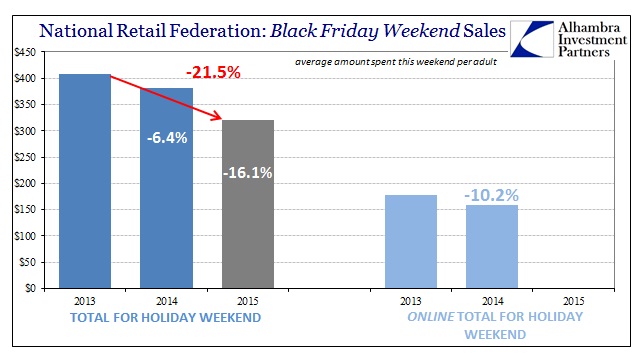The initial estimates for Black Friday spending are pretty grim; you can make that interpretation based only on the press releases themselves as neither of the words “strong” or “robust” appear in them. According to ShopperTrak, actual sales (mall sales) on Black Friday itself were up almost 15% from last year but only because there was a clear revulsion against shopping on Thanksgiving Day. By their estimates, shopping the day of the holiday totaled almost $3.2 billion in 2014, which was up sharply from just $880 million on Thanksgiving Day 2012, but plunged to just $1.8 billion this year.
By quick count of that math, overall spending combined for the two “Black” shopping days was down about seven tenths of a percent – but it will likely be a larger decline than that as ShopperTrak has changed its estimation methodology turning direct comparisons against prior released data to somewhat of a discontinuity.


The figures from the National Retail Federation are far, far worse. Their total for average spending per adult, which ranges far beyond the malls, for the entire weekend was down sharply. Reported to be $380 in 2014, the initial estimates for 2015 are less than $320! That is more than 21% below the $407 in average spending estimated for Black Friday weekend in 2013. Online shopping estimates have not yet been reported, but several ancillary indications point to largely the same trends as last year (which is not good).

That leaves most analysis open to a lot of subjectivity; for those that are predisposed toward the dominant recovery narrative, this is just confirmation that Black Friday is no longer the singular event it was once. Thus, what is clearly troublesome can be framed as, somehow, “strong” even though the retail tradegroups themselves are clearly avoiding that coloration.
Sales at U.S. brick-and-mortar stores on Thanksgiving Day and Black Friday were down slightly from last year, but the performance was still seen as strong in a holiday shopping season where discounts spread well beyond the weekend and many shoppers moved to the web.













Leave A Comment